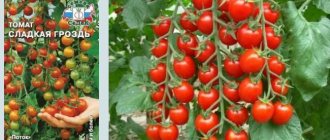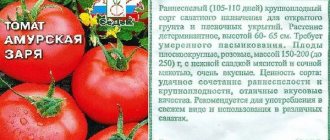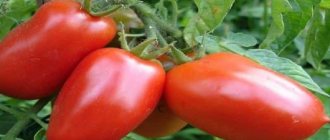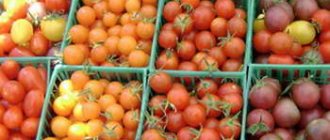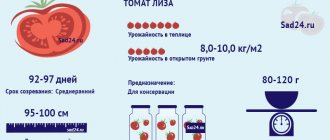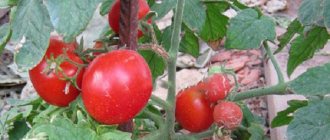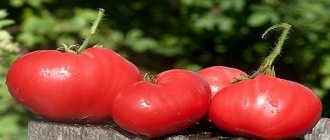Red bunch is considered a popular variety in the cherry group. Delicious sweetish fruits are suitable for fresh use and preparations. The variety pleases with early harvests. Grows well in garden beds and in home containers (on the balcony in pots, on windows).
| Height | Landing location | Ripening time | Fruit color | Fruit size | Origin | Fruit shape |
| short | Greenhouse, Open ground | Early ripening | Reds | Small | Variety | Round |
general description
The main advantage of the variety is the ability to grow throughout the Russian Federation. In southern regions or areas with warm climates, tomatoes can be grown in open ground. In the northern regions, plants need to be placed in a greenhouse.
“Red Bunch” is a determinate, non-standard variety . The height of the bush does not exceed 40–45 cm. It grows in width after pinching. On the main stem, after the appearance of 6 or 7 true leaves, long clusters with an abundance of fruits are formed - up to 30 pieces on one.
The plant has a strong and thick trunk. Powerful root system. Small dark green leaves. Corrugated, lint-free. It begins to bear fruit at the end of June - 90–100 days after the seeds germinate. Under favorable conditions, the fruiting period lasts until the end of September - beginning of October. Therefore, “Red Bunch” is grown not only in summer cottages, but also in small farms.
Advantages and disadvantages
The Red Bunch variety, like any other plant, has its own positive and negative traits.
Advantages:
- long fruiting period (about 3.5 months);
- early ripeness;
- high productivity;
- the formation of many clusters with a huge number of fruits;
- Tomato ripening is uniform and even;
- excellent taste;
- good keeping quality;
- transportability;
- crack resistance;
- strong immunity;
- resistance to temperature changes;
- not subject to sudden weather changes;
- universal use.
No wonder the Red Bunch is very popular not only among private owners and hobbyists, but also among farmers and industrialists.
Flaws
But the variety has very few or no disadvantages: after all, what is a disadvantage for someone is an advantage for another:
- in regions with cold climates it can only grow indoors;
- doesn't like drafts. Because of them, the likelihood of late blight increases.
There are no other comments or complaints about the Red Bunch.
Seedling
For a good harvest, it is recommended to grow seedlings rather than plant seeds in open ground. The seeds are disinfected and washed with water. Sow to a depth of 2–3 cm. Cover the container or pots with polyethylene. After the sprouts appear, it is removed.
When two true leaves appear on the stem, you can pick and fertilize. For replanting, it is better to choose a paper or peat pot. It will be possible to avoid damage to the roots when planting the plant in a greenhouse or open ground.
Planting and care
The Sweet Bunch should be planted in warm soil. If the soil temperature is below 12 °C, then there is no need to rush into planting. Prepare the soil a week before:
- dig up;
- add humus (compost), ash, fertilizers (urea, nitroammofoska);
- spill with Baikal EM1 or phytosporin if there were sick plants in the greenhouse last season.
Plant the seedlings in the evening, placing the holes according to the “3 plants per 1 m²” pattern. Water the planted tomatoes generously. Place the stakes immediately: Sweet bunch - a tall tomato and requires a mandatory garter.
Do not disturb the seedlings for two weeks. At this time, the bushes adapt to new conditions. There is enough moisture and nutrients during this period. If the weather is sunny in the spring, the greenhouse heats up. Young plantings can be shaded. Do not create drafts in the greenhouse - this variety does not tolerate them well.
Summer care
All summer you need to maintain the shape of the bush - remove stepsons. This is the main feature of the variety. A fast-growing bush requires regular tying to support. All other care activities are classic:
- watering;
- fertilizer;
- weeding;
- loosening;
- mulching.
Particular attention should be paid to mulching the soil. Mulch solves many problems:
- Delays moisture evaporation.
- Restrains the growth of weeds.
- Prevents the development of late blight.
- Prevents overheating of the soil in hot weather.
- Prevents soil cooling in cold weather.
Photos
Tomato Sweet bunch
The Sweet Bunch tomato is a relatively young variety; the registration number was received in 2009. Their originator is Moscow Agro. Its specialists have created a variety that can be grown both in open and protected ground. It is interesting to note that the Chocolate Bunch tomato is also on sale, but it is not included in the state register of breeding achievements of Russia.
Tomato variety Sweet bunch: characteristics and description
Refers to indeterminate tomatoes (unlimited growth). With good care, bushes can grow up to 2.5 meters or more, depending on conditions and climate. It is best to plant it in greenhouses, where the plants are formed, leaving 1 or 2 stems. This variety is well suited for cultivation in the northern regions of Russia, as it is early ripening - an average of 103-108 days pass from germination to fruit ripening.
Important! It is necessary to plant seedlings in open ground when the threat of frost has passed in the area, otherwise young plants risk dying even with a slight frost of −1-2 degrees. Tomato Sweet bunch
Tomato Sweet bunch
The fruits of this variety are small. Their weight averages from 20 to 30 grams. The tomatoes are round and dense, bright red. Many small fruits are formed on the cluster. At the same time, their maturation occurs gradually. Experts do not recommend selective harvesting; it is better to wait until the entire cluster is ripe and remove it completely.
The fruits have a good taste, but, despite their name, are not sweet.
Tomato care Sweet bunch
Most often, tomatoes are grown through seedlings, however, early-ripening varieties, which include the Sweet Bunch, can be sown directly into the beds, but only in warm regions. After planting seedlings in a permanent place, the plants need care and watering. It is better to water them infrequently - once a week in hot weather and once every two weeks if it rains. In the greenhouse, the bushes are watered once a week. Tomatoes do not like water and high humidity; in such conditions they do not form fruits and get sick. It is good if the air humidity is no higher than 47%.
Sowing tomato seeds
Important! The soil for tomatoes needs to be prepared in the fall. It is imperative to lim the soil, since it is lime that saturates the soil with calcium and magnesium
In addition, compost or good humus and bone meal are added to future beds. And we should not forget about crop rotation - you cannot plant tomatoes where they or other nightshades grew last year.
Sugar bunch tomatoes (as this variety is often called popularly) need a garter, like all indeterminate varieties. It is best to use twine, which is sold in specialty stores; bamboo sticks also work well.
Tomato Sweet bunch needs a garter
Stepchildren need to be constantly removed, since the plants form a maximum of two stems. Extra branches will take a lot of nutrition, taking it away from the fruit.
During the season, tomatoes should be fed at least three times. These can be either mineral fertilizers (urea, azofoska, saltpeter, special complex fertilizers) or organic (infusion of mullein or chicken droppings, herbal infusion). For better fruit formation, plants can be sprayed with the preparations “Bud”, “Sudarushka”, “Energen”.
Pros and cons of the Sweet Bunch variety
The Sweet Bunch series of tomatoes have few obvious advantages. These include early ripeness and the fact that the fruits perform well during heat treatment during canning (the tomatoes remain intact and do not burst).
Canning tomatoes Sweet bunch
Unfortunately, this variety has more disadvantages than advantages:
- A small amount of harvest (up to 3.5 kilograms from 1 bush). Planting rate: per 1 square meter - 3 plants. Thus, the yield from 1 square meter is on average 10 kilograms.
- Violent growth of stepchildren that need to be systematically removed.
- Susceptible to late blight.
- The fruits are unsweetened, their skin is dense.
The Sweet Bunch tomato is susceptible to late blight.
But, despite all its disadvantages, the Sweet Bunch series of tomatoes has found a place in greenhouses. It is valued by summer residents for its early ripeness and, to some extent, for its decorativeness.
Features of cultivation
Seedlings can be transplanted into a greenhouse approximately 40 days after germination. A tomato must have at least 5 leaves. The stem should grow to at least 20 cm. The recommended planting interval is 40 cm.
"Red Bunch" is unpretentious in care .
The bushes are loosened and watered with warm water. Provide them with good access to air and light. Do not forget that too bright lighting can destroy fragile plants. Fertilizers need to be applied 2-3 times until the first fruits appear. For prevention purposes, tomatoes are treated with special solutions against pests. Peeling is carried out periodically - approximately once every 2 weeks. The brushes are tied up or supports are placed for them.
Bush care
The soil for growing tomatoes of the “Red Bunch” variety must have a high level of acidity and good oxygen saturation.
The bushes need to be fed several times before the first fruits appear.
The following fertilizers can be used as top dressing:
- Boric acid;
- Ammonia;
- Hydrogen peroxide;
- Yeast;
- Iodine;
- Organic.
Twice a month it is necessary to pruning the plants.
Clusters with fruits need a garter. For this you should use horizontal or vertical trellises.
If necessary, mulching can be done. Tomatoes should be watered once every 7-9 days.
Harvesting takes place from the beginning of summer until September inclusive.
Pros and cons of tomato culture
Connoisseurs of Red Bunch tomatoes note the following advantages of the variety:
- They are small in size, often reminiscent of Cherry tomatoes, but different from them;
- They bear fruit within 3.5-4 months, evenly and in an organized manner. Tomatoes are early ripening;
- From one sq.m. you can collect up to 11 kg of delicious juicy tomatoes;
- The fruits are perfectly stored, do not burst, and are suitable for transportation;
- Plants are resistant to Solanaceae diseases and are immune to late blight;
- The tomato is not picky in care and easily tolerates temperature changes.
There are also several disadvantages:
- This variety can only be grown in cold regions in greenhouse conditions.
- The red bunch does not like drafts. In this case, the plant’s immunity to late blight is weakened.
Characteristics
Fruiting continues throughout the season with consistently large volumes. Resistant to bad weather conditions, changes in day and night temperatures. Uniform germination and fruiting were observed.
Main advantages:
- despite the small tomatoes, the variety’s yield is excellent - up to 10 kg per 1 sq.m.;
- delicious fruits;
- good storage;
- do not crack;
- disease resistance;
- unpretentiousness.
No deficiencies identified.
You can compare the yield of this variety with others in the table below:
| Variety name | Productivity |
| Red bunch | up to 10 kg per square meter |
| Nastenka | 10-12 kg per square meter |
| Bella Rosa | 5-7 kg per sq.m |
| Banana red | 3 kg per bush |
| Gulliver | 7 kg per bush |
| Lady Shady | 7.5 kg per square meter |
| Pink Lady | 25 kg per square meter |
| Honey Heart | 8.5 kg per bush |
| Fat Jack | 5-6 kg per bush |
| Broody | 10-11 kg per square meter |
Tomatoes are small and tasty, they are “salad” tomatoes and can be eaten fresh, in the preparation of salads and sandwiches. They do not lose taste in hot dishes. Ideal for canning whole fruits - they do not crack. It is used successfully for the production of tomato paste and juices.
Origin and application
The Red Red tomato variety was bred by Russian breeders and is intended for cultivation in different regions, except the northern ones. Closed ground is preferable: glazed greenhouses or film greenhouses. In areas with a warm climate, planting in open beds is possible. The collected fruits are well stored and can be transported. Tomatoes "Red Krasno F1", picked green, ripen quickly at room temperature.
The fruits are classified as salad fruits; they can be eaten fresh and used for preparing appetizers, salads, side dishes, soups, and purees. The smooth, beautiful fruits are stuffed and used to decorate dishes. Ripe tomatoes will produce delicious, sweet juice rich in amino acids.
Read on our website: the most
common diseases of tomatoes in greenhouses
And
ways to deal with them
.
Which tomatoes are resistant to most diseases and immune to late blight? What methods of protection against late blight exist?
Delicious, small, the size of grapes - Red Bunch tomato: full description of the variety
Assessment of those who grew:
Red bunch is considered a popular variety in the cherry group. Delicious sweetish fruits are suitable for fresh use and preparations. The variety pleases with early harvests. Grows well in garden beds and in home containers (on the balcony in pots, on windows).
| Height | Landing location | Ripening time | Fruit color | Fruit size | Origin | Fruit shape |
| short | Greenhouse, Open ground | Early ripening | Reds | Small | Variety | Round |
Description and characteristics of the variety
The red bunch belongs to the line of determinants (without a trunk). The shoots are compact and grow as wide as possible. The bushes reach a height of 50-60 cm. For better branching, the tops of the stems are pinched.
What are the features and characteristics of the variety:
- cluster friendly fruiting;
- precocity;
- low-growing compact bushes;
- determinant growth;
- 1 cluster contains 30-35 fruits;
- the root system is developed.
The variety belongs to the cherry type, produces tiny tomatoes up to 2-3 cm in size. Ripening begins early - the first clusters with neat tomatoes are removed 85-95 days after germination. Fruiting occurs smoothly and lasts until autumn for 3.5-4 months.
What is the description of tomato:
- average weight 30-45 g;
- cherry type;
- color bright red;
- the skin is tender;
- the pulp is juicy;
- the taste is classic.
Tomatoes are used in fresh dishes, for decoration, and whole-fruit canning.
History of creation
The variety was developed by Russian breeders. In 2000, the tomato was included in the State Register. Designed for planting in open beds in the southern regions (Krasnodar, Sochi, Crimea), under temporary film (in the middle zone and the Central region). In northern conditions they are kept in greenhouses.
Advantages and disadvantages
Pros:
- friendly maturation;
- productivity;
- unpretentiousness;
- keeping quality and transportability;
- excellent taste properties;
- marketability;
- resistance to a complex of infections;
- endurance;
- Possibility of cultivation at home.
Minuses:
- need for lighting and heat;
- poor tolerance to drafts.
Productivity
The red bunch is a productive cherry. 1.5-2 kg of crumbs are collected from 1 bush per season. From 1 m2 they collect up to 11 kg. Productivity is high.
Landing
Before sowing seeds:
- disinfect for 20 minutes in 1% potassium permanganate;
- soak in an activator (Zircon, aloe juice, Epin) for 10-11 hours;
- dried.
It should be planted to a depth of 2 cm in a nutritious soil mixture, which is purchased at an agricultural store or prepared from turf (peat and humus are added).
Sowing time: from February 20 (for temperate zones).
How to properly care for seedlings:
- Cover with film, which is opened slightly for 2 minutes for ventilation a couple of times a day.
- Moisten with warm water through a spray bottle, syringe, pipette.
- With 2-3 leaves, seedlings are fed with Gumat and Kemira.
- Turn on the phytolamps to avoid stretching.
- Gradual adaptation to lower temperatures. Procedures start from 15 minutes and last up to several hours.
- They dive when 1-2 leaves grow.
At 56-58 days, the bushes are transplanted to a permanent place, 4-6 plants are placed per 1 m2.
Growing and care
The bushes need a stepson, but can be grown without shaping.
The stems are tied to strengthen the brushes and prevent them from falling to the ground. Feed 4 times per season. Water regularly - 3-4 times a week.
Resistance to diseases and pests
The red bunch is immune to the following infections:
- late blight;
- verticillium;
- top rot.
Among the parasites feared are the invasion of aphids, mites, and whiteflies. Folk remedies are used in pest control:
- saline, soap solutions;
- garlic infusions;
- ash solutions.
To get rid of insects, tomatoes are irrigated with insecticides:
- Confidora;
- Aktarina;
- Karate.
Red bunch is an excellent choice for those who like neat cherry tomatoes with delicate pulp. Harvests can be obtained at any time at home, in the summer season in garden beds.
Source: https://repka.online/ovoshhi/tomaty/rannespelyie/krasnaya-grozd.html
Prevention of diseases and pests
Compliance with crop rotation rules and folk remedies will help prevent pests and diseases.
Pre-sowing tillage helps prevent diseases. For example, watering the soil with a solution of copper sulfate (according to the manufacturer's instructions) before planting plants. The variety is resistant to late blight and blossom end rot and is rarely affected by them.
Of all the pests, the variety is most susceptible to attacks by aphids. Garlic sprays repel her. The solution is prepared from 200 g of garlic, infused in 4-5 liters of water for 3 hours. Spraying is carried out in dry, cloudy weather.
Many pests do not like calendula, so it is recommended to plant these flowers along the edge of the tomato row.
